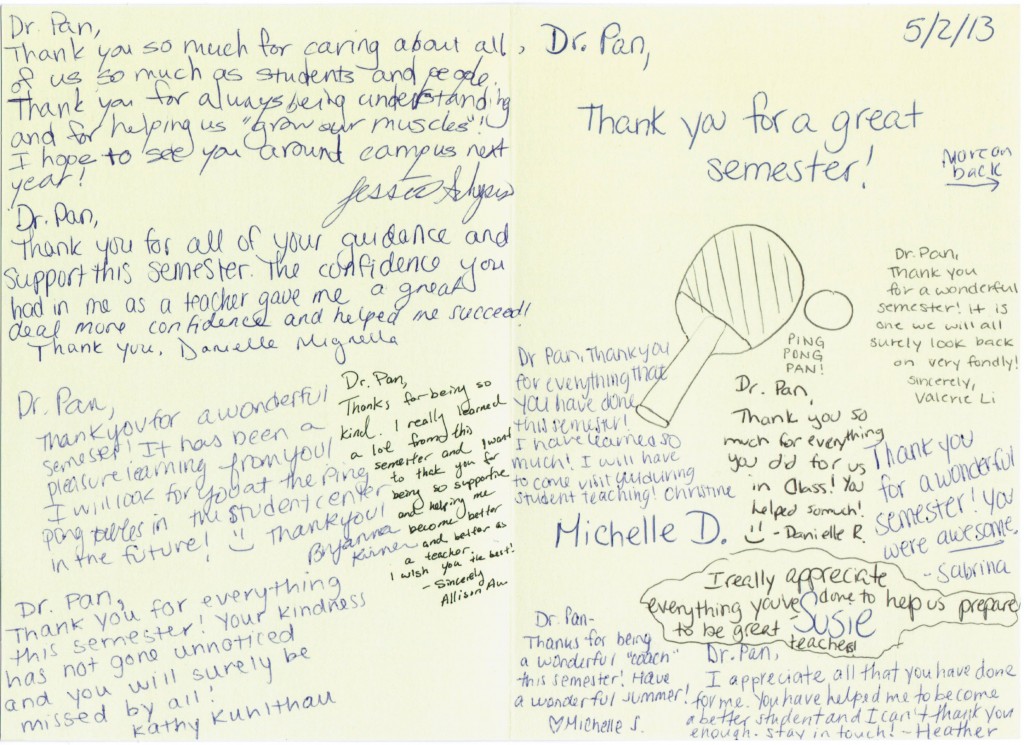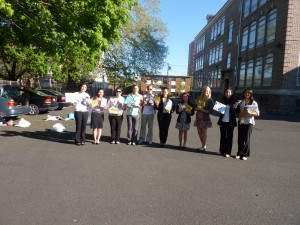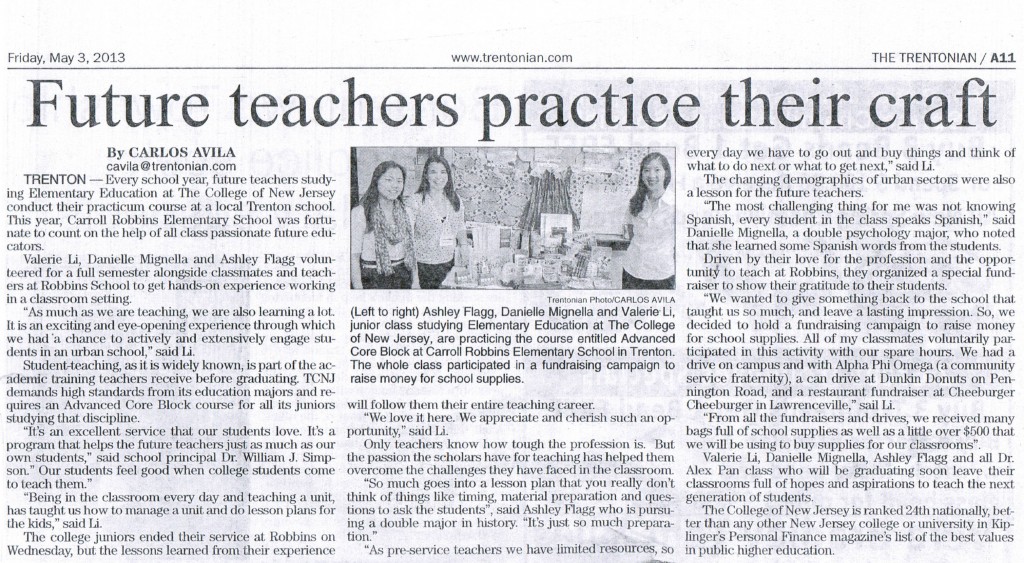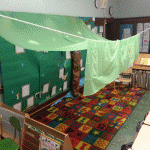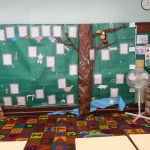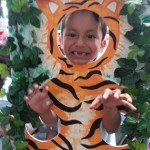To learn about those students whose mother tongues are not English and to figure out how to interact with them and help them achieve better, we need a firsthand experience to know how they feel and struggle to catch up with the rest of the class. Professor Jean Wong from the Special Education Department at TCNJ came to present a workshop on ESL to the ACB group. The following is from the class notes kept by Bryanna Kirner, from my ACB class:
To open, Professor Wong began by speaking to the group in Mandarin Chinese, and no English for about 15 minutes. She used all different forms of the Mandarin Chinese word “Ma,” pronouncing it in different ways and holding up cards to the group that showed different written pronunciations for it. Professor Wong used food, a cucumber, carrot, pineapple and banana to try and have the group figure out the mandarin meanings of the words “fruit” and “vegetable.” She also wrote the mandarin characters for these words on the board.
Professor Wong eventually spoke in English and explained to the group what she had been saying in Mandarin. Next, Professor Wong told the group a little bit about herself, and explained that she was a 1.5 generation America, meaning she was not born in a foreign country but she was raised speaking a foreign language in a non-English speaking home. Professor Wong explained her background as a child and her own ESL experience, she talked about growing up in a Laundry shop and the things that she remembered the most fondly. Professor Wong talked about a window that she and her siblings loved to practice writing with their fingers on when it became condensed with moisture. Professor Wong went on to talk about why she understands how ESL students feel because of her own experience as a generation 1.5 student.
Professor Wong talked about how we should use the term “ELL,” English Language Learners, as opposed to “ESL,” English as a Second Language. She told us this is a less condescending way of addressing the same thing. She also told us to heed caution about how many times we ask, “Do you understand?” because this could be taken offensively if the learner does understand. She provided an example of her father, and how he felt when people used to ask him if he understood over and over again.
Another interesting thing Professor Wong talked about was the significance of a lined notebook for students and how important it can be to them and their learning. She told us of how badly her and her sister wanted a notebook when they were young, but their mother made them brown paper notebooks from the extra wrapping paper in the laundry shop, and they had to draw in their own lines with a ruler.
Some of the strategies Professor Wong talked about talked about to help English Language Learners are:
- Find out their prior instruction
- Teach Oral Skills
- Vocabulary Development
- Lower Affective Filter
- Modify Linguistic Information and/or delivery
- Wider Variety and greater frequency of instructional strategies
- Collaborate with ESL Teacher – Teach lessons that relate in the ESL class and the mainstream classroom.
- Delivery – Accept 1 word answers, Allow yes or no answers, provide choice “this or that,” repetition, rephrasing
Professor Wong stressed that it is important for students to “Practice, Practice, Practice,” and “Review, Review, Review.”
She advised that we allow students to use their own language freely in the classroom, and not to overload them with too much information at once.
After a ten minute break, a second speaker named Ms. Natasha Agrawal, who is an ESL teacher at Robbins Elementary and a finalist for a National Teacher of the Year Award, spoke with us about her experience both as an ESL student as a child and her experience as an ESL teacher at Robbins.
Natasha told us about the three main types of ESL students she teaches: refugees, immigrants, and SIFE (Students Interrupted Formal Education).
First she talked in depth about refugee students. Being a refugee means the student came to America because they were forced out of their country for safety, often by the government. Natasha showed pictures of refugee camp, talked about how food is rationed, how US classrooms are a huge shock to the students, showed pictures of some of the symbols used in other languages instead of our alphabet, and talked about how many times refugee camps begin as temporary and then people end up living there for 20+ years.
She mentioned how most of her Spanish speaking students come from Guatemala, Mexico, Honduras and El Salvador. She said she worries for her Spanish speaking ESL students because she knows many of them have made the journey walking across the Mexico desert to arrive in America. Professor Wong read a story written by a second grader, Robert, who immigrated with his mother from Guatemala and walked across the Mexico desert to get to America, and then took a 15 days van ride across the country to come to live with his grandparents in New Jersey.
Photos were shown of some of the Spanish speaking ESL students at Robbins Elementary doing fun things such as drinking hot chocolate, having a picnic, receiving a letter from President Obama, and practicing a school play.
Some of the things we were told to expect in ESL students were a culture shock and a silent period where they will understand what you are saying but not be able to respond very much.
Some things that were advised NOT to do with ESL students are: assume child will “catch up,” assume someone will help them at home, and expect them to be able to complete the same worksheets as the English native speaking students.
Some things that were advised to DO is: Be respectful, involve their parents as much as possible, educate them about school, always remember that it takes 5-7 years to learn a language both socially and academically, so keep students in the ESL program for long enough that they became fully fluent and capable. Also, collaborate with the ESL teacher, provide appropriate support and homework, know the child’s background, find out their ACCESS score if they have been tested, make connections with the child.
ESL Models discussed include: Collaborative “Push In” Model, “Pull Out” Separate Classroom Model, and In class support
Undaunted was a book title that Natasha highly recommended, and described that it is about a student refugee.
Natasha closed with a quote that I thought was some really valuable advice: “Have fun with the students – They are in your life to teach you something.”
After she finished, Professor Wong took over again and went over the books on the list she provided for us. One that she especially talked about and highly recommended was The Spirit Catches You and You Fall Down by A. Fadiman. She recommended this book to be read by all teachers, and said that in many cases it is required for medical students and IV league students to read it.
Professor Wong closed her presentation by showing photos of her own children, Monica and Nathan, and talking about their success – Monica is an attorney, and Nathan is a graduate of TCNJ, is married, and is currently furthering his education at Temple University.
Professor Wong finished with leaving us with the question: “What’s in your bag of ESL tricks?”
Overall, I thought the workshop was extremely informative and definitely a productive couple of hours. I learned a lot! Thank you to our presenters!
—
Some extra information to add to the workshop follows:
ESL notes
Chinese words:
水果 [Shuǐguǒ] “fruit”
|
菠萝
|
[bō luó]
|
pineapple
|
|
|
[xiāng jiāo]
|
banana
|
菜 [cài] “vegetable”
The four tones in Chinese:
- First tone: ma1 or mā
- Second tone: ma2 or má
- Third tone: ma3 or mǎ
- Fourth tone: ma4 or mà
Mā mā mà mǎ mā? (Did Mother scold the horse?)
What are the generation 1.5 ESL learners?
As defined by Oudenhoven (2006)*, “Generation 1.5 students are immigrant students who move to the United States at the age of 12 or older and enroll in middle school or high school in this country.” The label comes from the group’s special place as first-generation Americans who migrate to this country during childhood and feel strong identification with the United States, yet are native to another country. This group has been identified by the National Academic Advising Association’s ESL/International Student Commission as a group that is rapidly growing and in need of special advising consideration (National Academic Advising Association, n.d.).
* Oudenhoven, E. D. (2006). Caught in the middle: Generation 1.5 Latino students and English language learning at a community college. (Doctoral dissertation, Loyola University Chicago, 2006). Digital Dissertations, AAT 3212980.
Also, here is the handout: ESL-info

